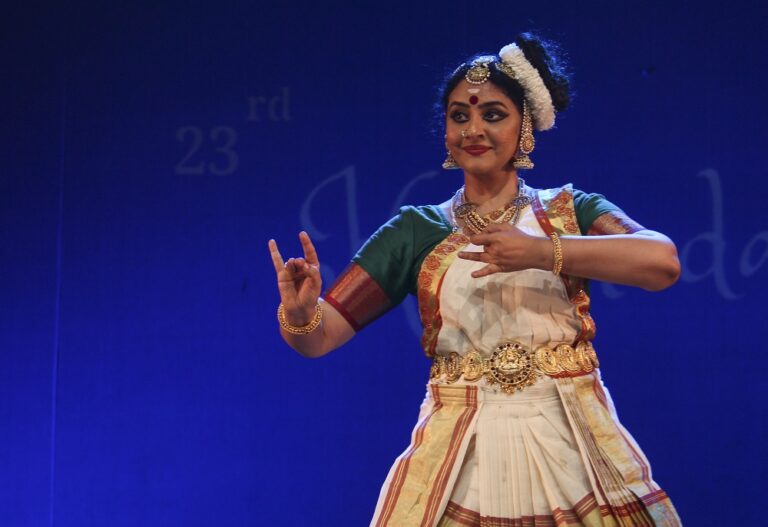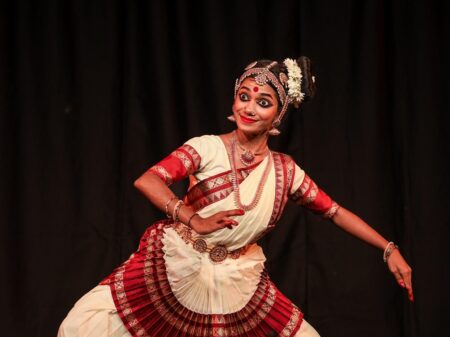A versatile Mohiniyattam dancer Methil Devika enriches her performances by innovatively integrating diverse content, music, and languages in her choreographies. Her recent production ‘The Crossover’, combines Indian Sign Language(ISL) with the hand gestures. On the side lines of the recent Peruvanam International Village Festival, Devika elaborates on the integration of ISL into dance and emphasizes the importance of inclusivity in art.
How has your research in ISL influenced the creation “The Crossover”?
“The Crossover” is a spillover of my project called HASTHAS- an acronym for ‘Hand Articulation in Spaces and Technologies from the Heritage and Aesthetic Sciences.’ During a Spicmacay program for the Deaf audience, I felt challenged not being able to narrate the story in the language of the Deaf and Hard of Hearing (DHH) Community. This inspired to include ISL into my dance creation. The project HASTHAS looks at using the principles of the traditional aesthetic sign language system across domains to create domain-specific gestural languages which include cryptic signs for the defense, astronomical sign language, and precision gestures for human-computer interaction.
For ‘The Crossover,’ I revisited my prior work, ‘Bramaniyammapattu,’ blending ISL with the aesthetic language of Mohiniyattam. Since the Hasthalakshanadeepika is not only a great source for an intricate aesthetic gestural language, but also has the added benefit of visually transcribing an entire text with all its grammatical elements, it made sense. Eventually, the gestural language became secondary as art transformed into a cohesive whole, exceeding boundaries and revealing a new dimension of language inclusion and artistic expression. My PhD, centered on the ‘Semiotic Understanding of Gestures to Facilitate Appreciation,’ found practical application in the production ‘The Crossover,’ showcasing its impact on theDHH audience. All gratitude goes to the organization ‘Dream of Us’ which supported me.
What ideas inspire your adaptation and choreography process?
While traditional pieces like Ashtapadis and Swathi Thirunal‘s padams have long been integral to Mohiniyattam, there was a historical absence of ‘voices of women. My work ‘Uchchila’ addresses this gap in the folktale of Muchilottu Bhagavathi, emphasizing the importance of women’s expression, even in silence. I pose questions to the audience, exploring the impact of ignorance and knowledge on society. This resonates in today’s context, where misinformation is weaponised. Delving into open-ended myths, I provide reasoned solutions. Through my art, I strive to highlight the significance of women’s voices and challenge societal norms.
Why should an artist/choreographer document the work?
Documenting work is essential for immortalising a piece, ensuring it reaches a global audience and safeguarding against plagiarism. In my 28-year old career as a creator a significant portion of my creations remains undocumented, a common challenge for many artists. In an era fixated on social media publication dates, the extensive documentation process, covering rehearsals, planning, and entire performances, becomes crucial. Collaborating with the technical crew enhances the program, but compromises are inevitable due to varying spaces and circumstances. The ideal performance often only exists in one’s imagination, constrained by budget limitations.

How do you integrate multilingual music into Mohiniyattam, and what are your thoughts on live singing in performances?
I choose compositions that align with the structure of Mohiniyattam, ensuring a focus on different ragas that blend within the dance’s framework. Being both a dancer and a music composer, I value both ‘live’ singing and recorded music. Live singing gives a fresh perspective to each performance. With the singer and percussionists, we work together to convey the piece’s essence to the audience. However, this approach may highlight a vocalist’s strength in a specific genre only, potentially missing out on other musical styles and approaches.
In contrast, recorded music offers the flexibility to explore a diverse range of genres, from traditional to folk-infused pieces, giving me the freedom to decide which works well where. This versatility enables me to create different work, challenge myself, understand more, and switch between tradition and innovation.
Have you noticed the tendency to fixate on a performer’s image?
Many judge performers based on just a few performances. It is important to see an artiste over a few years and then judge. Personally, I aim to broaden my artistic scope. While staying within a familiar space may seem secure, embracing challenges and conquering them allows a performer to learn and grow. It gives a wealth of experience.
What is your perspective on inclusivity in art and how do you handle criticisms?
Indian classical dance is inherently exclusive, and the concept of ‘inclusion’ can be misconstrued as ‘intrusion.’ Changes in established spaces pose challenges, but overcoming them fosters transformation and evolution. Dealing with criticism, especially in the era of social media, requires a thoughtful response. The artist emphasizes promoting equality and inclusiveness through art, detaching from completed projects and viewing each work as a new exploration.

Your perspective on the intersection of art and politics?
Today, personal opinions are often politicised hindering genuine self-expression. There have been times when I have blatantly responded to problems and just because the opposite could not bear to perceive me as a woman capable of having an individual opinion, they cast me into a political party. That seems to be the safest thing to do for them to get support. The upcoming generation faces challenges to create new work.
Whether you stick to tradition, or weave new content, prepare to be bullied. You can have constructive criticisms, but dance fraternity as a whole should stay strong as a collective entity. The steering will depend on whether they want to use art for activism, self-expression, experiencing beauty or artistic relish. One will have to manoeuvre accordingly. If you practice art for sheer artistic delight, then you may be better off and peaceful in your space. If your intention is to scrutinise someone else’s work, then social media is the world for you.
For me, happiness stems from the simple daily blessings and the joy of collaborating with fellow artists and compassion comes at the forefront.
Photo: Jibu K. Rajan, Rakesh Nair, Akshaya




